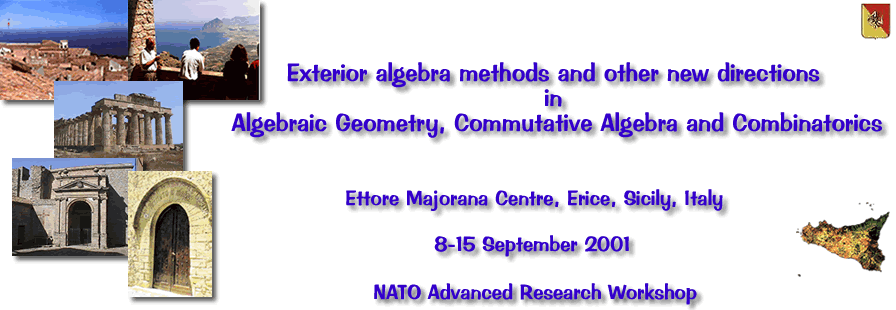
|
Event photos The workshop in Erice will address a wide range of new developments in classical Algebraic Geometry such as curves and their moduli, surfaces, higher dimensional varieties, vector bundles, and toric varieties. A special focus will be on exterior algebra methods which have recently grown in importance in Algebraic Geometry, Commutative Algebra, and Combinatorics, and their computational aspects (Bernstein-Gel'fand-Gel'fand correspondence, Beilinson monad, theory of Chow forms and resultants, algebraic shifting, free resolutions over the exterior algebra, linear syzygies, hyperplane arrangements, ...) |
| Organizing Committee: David Eisenbud, Lucian Badescu, Sorin Popescu and Alfio Ragusa |
|
Speakers
(tentative): The following people have responded
positively to our invitation: L. Avramov (Purdue), A. Beauville (Nice), R. Buchweitz (Toronto), F. Catanese (Goettingen), C. Ciliberto (Rome), W. Decker (Saarbruecken), L. Ein (U.I. Chicago), G. Ellingsrud (Oslo), Gunnar Fløystad (Bergen), M. Green (UCLA), J. Harris (Harvard), J. Herzog (Essen), A. Hirschowitz (Nice), G. Kalai (Hebrew U), A. Khovanskii (Toronto), I. Peeva (Cornell), Ch. Peskine (Paris VI), D. Popescu (Bucharest), C. Procesi (Rome), K. Ranestad (Oslo), J-E. Roos (Stockholm), F.-O. Schreyer (Bayreuth), I. Sols (Madrid), M. Teicher (Bar-Ilan), A. Thoma (Ioannina/Purdue), Ch. Walter (Nice), F. Zak (Moscow). |
| Sponsors: NATO Scientific Affairs Division, EAGER: European Algebraic Geometry Research Training Network and the University of Catania, Sicily. |
| Registration: The cost of staying at the Ettore Majorana Centre will be approximately $80 per night (lodging/meals/transfer from/to the airport/1/2 day trip included), and there will be a fee of $100 for the social events. We will be able to offer financial assistance to some of the participants, particularly to younger mathematicians and speakers. Moreover, EAGER: European Algebraic Geometry Research Training Network will also support a number of participants from Europe, especially younger mathematicians. If you are interested in attending the workshop, please fill out this registration form. European participants seeking EAGER support should apply for financial support directly to their node and then fill out the above registration form. |
|
Location:
The workshop
will be hosted by the Ettore
Majorana Centre for Scientific Culture, founded in 1963 in the pre-medieval
mountain town of Erice situated near Palermo in Sicily. The centre is named
after the Italian Physicist, Ettore Majorana. Its lecture halls ("Richard P.
Feynman", "Paul A.M. Dirac" and "Enrico Fermi") are located in two restored
monasteries (San Rocco and San Domenico) and the ancient Palazzo Ventimiglia
- former residence of the Viceroys of Sicily and subsequently a convent named
after San Francesco. Here is the view you
may enjoy during coffee breaks ... Workshop participants are housed in the Centre Institutes or local hotels and meals are taken at local restaurants. |
|
According
to legend, Erice, the son of Venus and Neptune, founded a small town on top
of a mountain (750 Meters above sea level) more than three thousand years ago.
Thucydides (~500 B.C.) writing about events connected with the conquest of Troy
(1183 B.C.) says: «After the seizure of Troy some Trojans on their
escape from the Achaei arrived in Sicily by boat and as they settled near the
border with the Sicanians all together they were named Elymi: their towns were
Segesta and Erice.» This inspired Virgil to describe the arrival of
the Trojan royal family in Erice and the burial of Anchise, by his son Enea,
on the coast below Erice. Homer (~1,000 B.C.), Theocritus (~300 B.C.), Polybius (~200 B.C.), Virgil (~50 B.C.), Horace (~20 B.C.) and others have celebrated this magnificent spot in Sicily in their poems. In Erice you can admire the Castle of Venus, the Cyclopean Walls (~800 B.C.) and the Gothic Cathedral (~1300 A.D.). Erice is at present a mixture of ancient and medieval architecture. Other masterpieces of ancient civilization are to be found in the neighborhood at Motya (Phoenician), Segesta (Elymian) and Selinunte (Greek). On the Aegadian Islands - theater of the decisive naval battle of the first Punic War (264-241 B.C.) - neolithic and paleolithic cave paintings and carvings are still visible in the grottos of Favignana and Levanzo. Splendid beaches are to be found within about an hour's drive from Erice at San Vito Lo Capo, Scopello and Cornino. |
(Photos and historical comments from the
Ettore
Majorana Centre website)